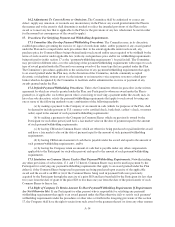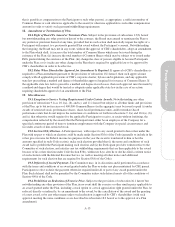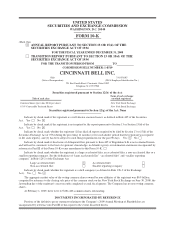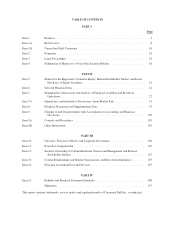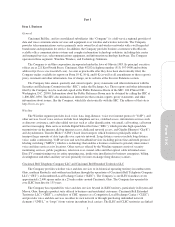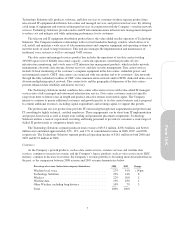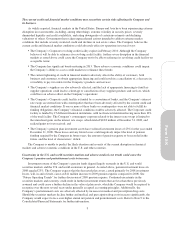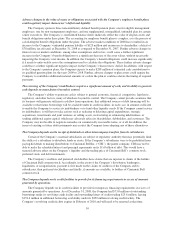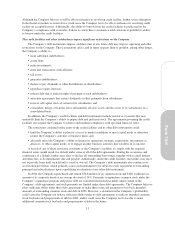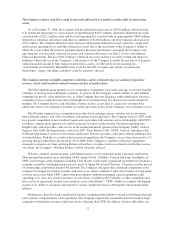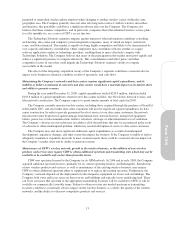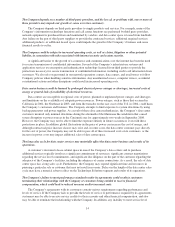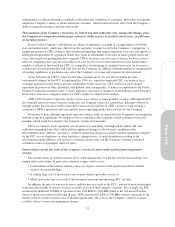Cincinnati Bell 2008 Annual Report Download - page 108
Download and view the complete annual report
Please find page 108 of the 2008 Cincinnati Bell annual report below. You can navigate through the pages in the report by either clicking on the pages listed below, or by using the keyword search tool below to find specific information within the annual report.Additionally, the Company’s mix of business and consumer customers is changing, as many of the
Company’s growth products, such as data center services and data transport services, are geared primarily toward
business customers. In 2008, the Company’s revenues were comprised of 59% to business customers and 41% to
consumers. By comparison, the Company’s 2005 revenues were comprised of 53% to business customers and
47% to consumers.
Employees
At February 1, 2009, the Company had approximately 3,300 employees. CBT has approximately 1,200
employees covered under a collective bargaining agreement with the Communications Workers of America
(“CWA”), which is affiliated with the AFL-CIO.
Business Segment Information
The amount of revenue, intersegment revenue, operating income, expenditures for long-lived assets, and
depreciation and amortization attributable to each of the Company’s business segments for the years ended
December 31, 2008, 2007, and 2006, and assets as of December 31, 2008 and 2007, is set forth in Note 14 to the
Consolidated Financial Statements.
Item 1A. Risk Factors
The Company’s substantial debt could limit its ability to fund operations, expose it to interest rate volatility,
limit its ability to raise additional capital and have a material adverse effect on its ability to fulfill its
obligations and on its business and prospects generally.
The Company has a substantial amount of debt and has significant debt service obligations. As of
December 31, 2008, the Company and its subsidiaries had outstanding indebtedness of $2.0 billion on which it
incurred $139.7 million of interest expense in 2008, and had total shareowners’ deficit of $709.3 million. In
addition, at December 31, 2008, the Company had the ability to borrow additional amounts under its revolving
credit facility totaling approximately $151.4 million, subject to compliance with certain conditions. The
Company may incur additional debt from time to time, subject to the restrictions contained in its credit facilities
and other debt instruments.
The Company’s substantial debt could have important consequences, including the following:
•the Company will be required to use a substantial portion of its cash flow from operations to pay principal
and interest on its debt, thereby reducing the availability of cash flow to fund working capital, capital
expenditures, strategic acquisitions, investments and alliances, and other general corporate requirements;
•the Company’s interest expense could increase if interest rates, in general, increase because approximately
30% of the Company’s indebtedness is based on variable interest rates;
•the Company’s interest rate on its revolving credit facility depends on the level of the Company’s
specified financial ratios, and therefore could increase if the Company’s specified financial ratios require a
higher rate;
•the Company’s substantial debt will increase its vulnerability to general economic downturns and adverse
competitive and industry conditions and could place the Company at a competitive disadvantage
compared to those of its competitors that are less leveraged;
•the Company’s debt service obligations could limit its flexibility to plan for, or react to, changes in its
business and the industry in which it operates;
•the Company’s level of debt and shareowners’ deficit may restrict it from raising additional financing on
satisfactory terms to fund working capital, capital expenditures, strategic acquisitions, investments and
joint ventures and other general corporate requirements; and
•a potential failure to comply with the financial and other restrictive covenants in the Company’s debt
instruments, which, among other things, require it to maintain specified financial ratios could, if not cured
or waived, have a material adverse effect on the Company’s ability to fulfill its obligations and on its
business and prospects generally.
8


